TICKERS: AU; ANG; AGG; AGD, CMMC; CPPMF, , FNX, IMG; IAG, , MXY, ML, MMC, QUX, , UEC
Gianni Kovacevic: China Growth and Energy Profits
Interview
Source: Tim McLaughlin and Karen Roche of The Energy Report (4/15/10)
 China is building an impressive amount of infrastructure," notes Kovacevic Consultants Principal Gianni Kovacevic, who forecasts continuing demand for, and increasing upside in, energy and resource stocks. In this exclusive interview with The Energy Report, Gianni explains how China's infrastructure boom will continue, presenting great opportunities for investors.
China is building an impressive amount of infrastructure," notes Kovacevic Consultants Principal Gianni Kovacevic, who forecasts continuing demand for, and increasing upside in, energy and resource stocks. In this exclusive interview with The Energy Report, Gianni explains how China's infrastructure boom will continue, presenting great opportunities for investors.
Gianni Kovacevic: About six months ago, I signed up for that sponsorship. I decided back then that I wouldn't just arrive in Hong Kong. I wanted to take the train across China and get a real first-hand feel. I've been to Asia before and I've been to most of the countries in Asia, but I wanted to go across the landscape and take a look. Sort of like the 1987 movie Planes, Trains and Automobiles; I just added rickshaws to the mix. I already had a really good sense of what's going on, but from visiting the eastern seaboard of China and talking to people from all walks of life, I got a sense of their daily lives, their quality of life, and what they are looking forward to.
TER: Do you still see China as a big player in the mining markets?
GK: There are people who will tell you that China is building the bridge to nowhere, or the road to nowhere. Let's look back at history. History teaches us everything. Ever since Moses left Egypt, the situation has been, "if you build it they will come." We've seen this happen time and time again. In France, in the 1800s, 20% of the people lived in the cities, 80% lived rurally. That flipped. In America, it flipped during the 20th century, after the biggest road to nowhere project that took place to this date. That was the 46,000 miles of interstate highways that were built in the U.S. after the Second World War, and we all know what happened there.
China is building an impressive amount of infrastructure, but it's required. They have what I call a youth brain drain from rural China. These villages are losing their youth. They all want to have a piece of the action. Information moves so fast. They know it's out there. They want to get it and they're getting it. You go to the shopping malls in China and people are walking out one after the next with a television or an air conditioning unit. These status symbols that we take for granted, they're buying for the first time. The infrastructure that still needs to get built is mind-boggling.
TER: A lot of people seem to think that there's a China bubble. It seems you don't agree?
GK: They keep saying this year after year. There perhaps could be some overbuilding. In the Pudong area of Shanghai; some would say it is overdeveloped. It's for the most part full now. That's what sophisticated "in the know" and "in the building" people are telling me. They know.
I met with managing directors of banks and they tell it the way it is. They say it worked. There may be some vacancy, but there's certainly a sufficient amount of occupancy.
Another very common, very well-publicized story in the media is the injection of capital. In one of the talks in Hong Kong, one of the bankers gave a very good presentation on this exact question. Within that presentation, it stated that corporations in China have taken just over 23 trillion RMB (USD$3.5 trillion), Chinese currency, in loans. The interesting thing is they still have not spent over 50% of it. It's still sitting in cash. So if you haven't spent the money, how can that be a bubble?
TER: There's been some monetary tightening in China. Do you see that continuing to happen?
GK: I would suggest that they know what they're doing and how they're going to do it. They have these long plans, 5-year and 10-year plans. Which is exactly why, in the teeth of the crisis that took place in the last 18 months, they were out deploying hundreds of billions of dollars to get long-term supplies of all the commodities they don't have at home. They understand pretty well where they're going.
They have people coming into the eastern seaboard by the tens of millions. The train ride I took from Beijing to Shanghai, just over 1,600 kilometers, travels between 200 and 137 kilometers an hour. Parallel to this railroad track, they're building a new railroad that is going to travel a little more than 300 kilometers an hour. It's coming with new stations in the big cities. It's elevated on concrete stilts for a good portion of the distance.
When you have the biggest migration of human beings in the history of the world taking place by the tens of millions, there's not enough space. The train ride I took was only 1,600 kilometers, which would be like a train ride from Boston to Atlanta. Imagine moving the entire population of the United States, 250 million or 300 million people, to a strip of land that size. Tell me the amount of infrastructure that's going to be required. That's happening and has happened over the past 20 years and will continue.
TER: So is the opportunity, in terms of playing this Chinese growth, infrastructure or consumer products?
GK: When you look at the very basic buildings blocks of an economy, you have steel, concrete, copper and oil. You're going to have the most leverage out of those commodities that they don't have enough of (i.e., copper, oil, steel and the things that are used to create steel). You can't grow an economy without those things. Even in the darkest day of the recession, they were out deploying hundreds of billions of dollars.
Take copper, for example. Stockpiles increased over the past year from 250,000 tons to over 500,000 tons. For the first time, the price climbed with it. This is because we're playing by new rules. If you look at the old rulebook, you're going to get it wrong. You cannot do that.
TER: So, you think China is going to be the principal driver of the demand for copper?
GK: Yes, I do, because it's a never-ending loop. The way we generate, transmit and utilize electricity is where the vast majority of the world's copper is being used. For more than 100 years, we've been globally deficient in electrical generation. So that continues.
China will have its own initiatives, whether it's going to be from cleaner coal or nuclear power or some kind of green energy, wind, or what have you. They're going to create more electricity because they have to. They have to transmit more electricity because of this massive migration, equivalent to the population of America moving to an area of a couple thousand kilometers. Those people are going to continue to utilize electricity.
Let me give you some examples—status symbols. You have to have an air conditioning unit now to have status in China. You don't sweat; you live in comfort. That unit itself has about 10 to 15 pounds of copper between all the tubing, all the windings, and all the wires. It's the most energy-intensive product that one can buy for one's home here or there. Old communities have had to fortify their electrical systems. New communities need to have more ability to generate and transmit electricity because people keep utilizing more electricity with this product.
The Chinese, again, I stress the 300 million people who have buying power, are just like us in the developed West. We don't have two or three electric gizmos in the household. You might have 20 or 30. It takes hundreds of thousands of tons of copper per year just to satisfy the building blocks of those air conditioning units. Then the second part of it is providing the electricity. Look at Moscow. During two or three month of the summer, everybody's got air conditioning on. You have to fortify the whole electrical grid for those two or three months when they all turn on in order not to crash it the overall system. Remember Brazil last year? The Eastern Seaboard a few years ago? Governments don't have a choice. They are going to have to prepare for more usage, and there will be a lot of copper demand.
TER: What other resources are good plays, given this idea that China is still going to be the driver?
GK: Demand for other resources is inevitable. Oil is an example. We look at China as the world's largest market for automobiles. Just this week, the China Association of Automobile Manufacturers reported that sales reached 1.74 million units in March, up 56% over March 2009, or 20.43 million units on an annualized basis. As well, Q1 vehicle sales were at 4.61 million units, or 18.7 million on an annualized basis— 37% higher than total 2009 sales. The U.S. market had reliable sales of 14 to 17 million units between 1995 and 2007, so one can see that China is at American boom-time levels already, 10 to 15 years ahead of most experts' forecasts. That happened last year, in part because of the decimation of the U.S. automobile market, which fell to about 10 million units. Can the 300 million people in China with spending power maintain a reliable purchasing pattern similar to that in the U.S. before the financial crisis? Absolutely, which, in my opinion, debunks the bubble theory for cars and many, many other categories in China. It's going to keep growing as those who have not participated in basic progress obtain their first basic items. That's extremely bullish for oil. The biggest status symbol for someone in China is to have a car. Bicycles are not that prevalent anymore, particularly in the big cities where people are driving cars. And they're driving fine cars.
Here's another commodity that's really interesting. If copper is the life blood of the economy, I call molybdenum the glue of the economy. It holds the whole economy together. Again, you cannot grow as an economy without molybdenum. It's what we use to strengthen steel. It's put in steel to resist heat. It takes sulfur out of diesel fuel. It's being used in all those different products where specialty steel is used.
The question right now is, where's that threshold and where's the future for molybdenum? A pipeline project is a good example. If you fortify a pipeline with around 0.75% of molybdenum, each kilometer of large diameter pipeline will need about 1,000 pounds of molybdenum. At $17 or $18 a pound, it costs you $17,000 a kilometer to fortify that pipeline for long-term performance. If molybdenum goes to $30 a pound or $40, it would cost, say $30,000 a kilometer to fortify that pipeline for long-term performance. Is this going to prevent you from using it at a few million dollars per kilometer? Of course not. In almost every single application of molybdenum, the price almost does not matter. You're going to pay for it and you're going to use it. However, there could be an oversupply in four, five or six years. The question for investors is what to do in the next 18 months? The next 24 months? I would say there's a considerable profit to be made, or potential profit to be made, within the molybdenum space, but it's a very difficult thing to invest in, though.
TER: You mentioned that we should take advantage of this molybdenum opportunity for the next 18 to 24 months. Then you said immediately afterwards, it's hard to take advantage of it. So what does an investor do?
GK: Well, on February 22nd of this year, the London Metals Exchange (LME) began offering contracts for both cobalt and molybdenum. That is something that has given an alternative market to people who have excess molybdenum. It would have been nice for the moly market to have had that when it crashed from $30 to $8 in a couple of weeks during the crisis. It's also given a little more transparency to a truer supply and demand situation. How an investor profits from this is extremely difficult. There are four or five good companies in the junior space that, unfortunately, have been decimated through dilution, but they're very valid opportunities. The one that we've talked about before is Mercator Minerals Ltd.(TSX:ML). It's a copper-molybdenum mine located in Arizona. They continue to have had a delay with optimal phase two operations. They're raising a credit facility for about $17 million. The other default company would of course be the well-known Thompson Creek Minerals Co. Inc.(NYSE:TC;TSX:TCM).
TER: Quadra Mining Ltd. (TSX:QUA) has also made news recently. Talk to us about that.
GK: Quadra is sort of a default company in the mid-tier copper production space. It's also located in very good places, Arizona, Nevada and Chile. They recently had a significant investor, an Asian investor, for their Sierra Gorda project. Of course, most recently they've announced a share merger with FNX Mining Co. (TSX:FNX) to create Quadra FNX. People are still mulling over the ramifications to that. I have been extremely bullish on Quadra. We all may remember it fell to $2 per share from a high of $27. Ever since, the analysts have been very much divided. Now the shares are trading around $16, with a high of around $18.
We want to understand what it means for the shareholders going forward. With this merger, you have two very entrepreneurial, two very successful management teams. The teams have somewhat different skill sets, but they both come from a very good background. I would suggest that they're going to complement each other very well. Paul Blythe, the CEO of Quadra Mining, will continue to be the CEO of this new Quadra FNX Mining. That's something I think people should definitely follow.
TER: Any other copper companies you're following?
GK: Sure, let's see. Copper Mountain Mining Corp. (TSX:CUM) is a company I've always supported. It's just a fantastic British Columbia story. They're going to be producing copper within 12 to 14 months. That is fantastic news both for the province and for the copper world. It'll be about 50,000 tons a year production. They've got a great partner in Mitsubishi Materials Corp. (Fkft:MUJ). Let's not forget they've had $170 million worth of infrastructure that was there because of the past production. This company had a market cap of maybe $10 million at the low. There was just a tremendous amount of deep, deep value there. The stock's up 1000% from the low, so it was tremendous story.
TER: Are there any companies that are undervalued, or any that have not moved yet in this market?
GK: Magma Energy Corp. (TSX:MXY) is a company with one of the best management teams from the past couple of decades in the mining space here in Canada. The IPO last July was $1.50 a share. Since then the stock climbed about $2. The company has grown their resources. They've grown their production. They're now about 86 megawatts online production. They can grow that to about 120 megawatts without going to the market. They've increased their resources in Chile. They're over 300 megawatts of what they call an inferred resource now in Chile. They have Soda Lake, which is expanding. They've done everything they said they would do. It's a fantastic story with a tremendous amount of asset growth and the stock is back to the IPO level. It's a deep value growth story that has not run with the market as the entire geothermal space has been sold off, likely by a few investors who had exposure to these few companies. A good opportunity.
TER: On the energy theme, you have commented on green energy in the past, and geothermal fits in that category. Any other ideas in that arena?
GK: I have followed Uranium Energy Corp. (NYSE.A:UEC) for years, and it's my uranium stock of preference due to a number of factors. First of all, it's "green" energy, as many states in the U.S. have included nuclear power in their mandated basket of must-produce low carbon energy creation. How that is I have no idea nor do I care; however, I know that nuclear power is a key pillar to this force-fed green energy plan. UEC is going to be the next producer of uranium in the world and they are located in South Texas. Their Hobson facility is permitted, built and they have zero debt. In fact, just they just announced the sale of a non-core asset in New Mexico for $11 million cash, so they have $26 million of cash, which is a great war chest. Sixty million shares outstanding, no debt, 1 million lbs of uranium production set for the end of this year, with seemingly no dilution to fulfill other strategies. We like that, and that's why it's our favorite in the uranium sector.
TER: Do you see any other companies that are undervalued the same way that Magma might be?
GK: North Atlantic Resources Ltd. (TSX.V:NAC) is that kind of company. In full disclosure, we have a position in this company. North Atlantic Resources is operating in the country of Mali. It's a gold target. They have numerous different assets. The project they're going to work on with this latest financing is their FT Gold Project. According to management, with their 600,000-ounce resource, they're going to infill that and do some work on other anomalies to test it for more ounces. With a current market cap of $10 million, you have a current resource that requires a very minor investment in drilling expenses to expand known resources. I would say they would spend maybe a million-and-a-half dollars drilling to see how they can improve its size and quality. They're surrounded by successful neighbors. You've got AngloGold Ashanti Ltd. (NYSE:AU;JSE:ANG;ASX:AGG; LSE:AGD), IAMGOLD Corp. (NYSE:IAG;TSX:IMG) and Etruscan Resources Inc. (TSX:EET) as neighbors. There are big deposits in that area. One is 11 million ounces, another is 13 million ounces.
North Atlantic Resources is a company that some years ago was trading at around $4.50 a share. Management over-promised and under-delivered, so the shares crashed all the way back down to pennies. Any company that can demonstrate the potential to have a +1 million oz gold deposit that trades at a $10 million market cap is worth keeping on the radar screen, especially when they are going to start a work program around known resources. We'll follow this one very closely.
TER: Thank you for your time.
Gianni Kovacevic (www.kovacevic.com) is a corporate development strategist who targets natural resources, with a focus on copper and gold. He is proud of the fact that his countless hours of research and reading, fortified by relationships and access, have delivered time and again, solid advice and recognizable results. Fluent in German, Italian and Croatian (and studying Russian), Gianni spends his time between Vancouver and Zurich, and attends major conferences around the world. He has an ongoing commitment to sustainable development in the communities where he focuses his interests. He is working to provide youth who live around mining projects with an opportunity to learn English, which he believes establishes an important lifelong skill to improve the living standards of their families and overall community.
Want to read more exclusive Energy Report interviews like this? Sign up for our free e-newsletter, and you'll learn when new articles have been published. To see a list of recent interviews with industry analysts and commentators, visit our Expert Insights page.
DISCLOSURE:
1) Tim McLaughlin of The Energy Report conducted this interview. He personally and/or his family own shares of the following companies mentioned in this interview: None.
2) The following companies mentioned in the interview are sponsors of The Energy Report or The Gold Report: Copper Mountain, IAMGOLD, North Atlantic Resources.
3) Gianni Kovacevic: I personally and/or my family own shares of the following companies mentioned in this interview: Quadra, Magma Energy, Uranium Energy and North Atlantic Resources. I personally and/or my family are paid by the following companies: Uranium Energy Corp.



































